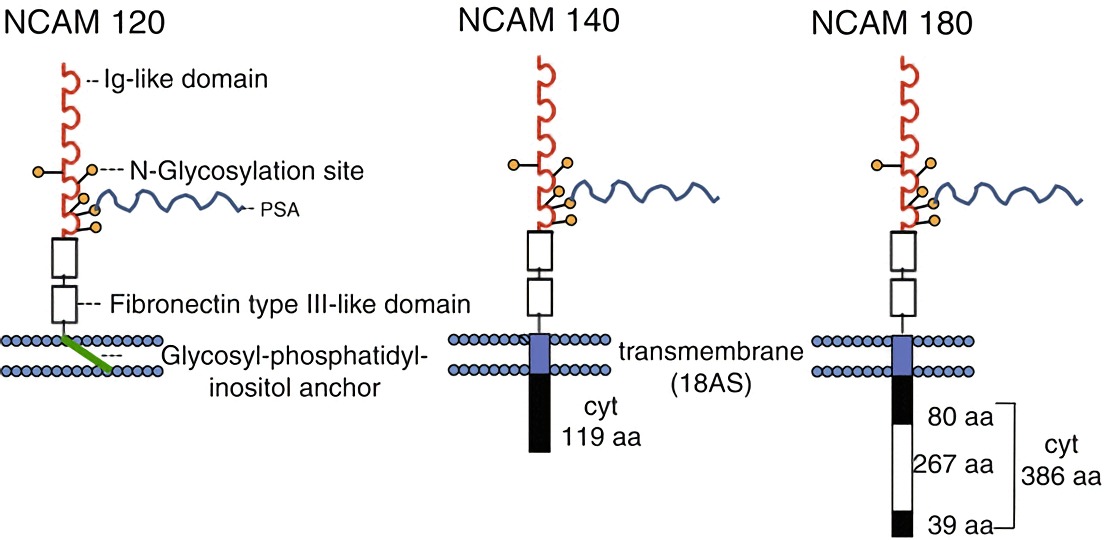CD56 Assay Portfolio Service
Overview
CD56, also known as the neural cell adhesion molecule (NCAM), is a membrane glycoprotein of the immunoglobulin superfamily. CD56 is mainly expressed by neurons, glia, skeletal muscle, and natural killer (NK) cells. Functionally, CD56 contributes to cell-cell adhesion or cell-matrix adhesion during embryonic development. CD56 is a neural cell adhesion molecule that plays a role in the cohesiveness of neuroendocrine cells. In addition, CD56 has been detected on lymphoid cells, including NK cells, γδ-T cells, and activated CD8+ T cells, as well as on dendritic cells (DCs), that may have an immunoregulatory function.
Characteristics
At least 27 alternatively spliced CD56 mRNAs produce several isoforms. The human NCAM gene is located on chromosome 11q23. CD56 contains a 689 amino acid extracellular domain which contains 5 Ig-like C2-type domains, 2 fibronectin type-3 domains, and 6 potential N-glycosylation sites. CD56 exists three main isoforms (NCAM-120, NCAM-140, and NCAM-180), all generated by alternative splicing from one single gene. These main isoforms of NCAM vary only in their cytoplasmic domain:
-
NCAM-120kDa (GPI anchored)
-
NCAM-140kDa (short cytoplasmic domain)
-
NCAM-180kDa (long cytoplasmic domain)
 Fig.1 Three isoforms of CD56. (Horstkorte, 2012)
Fig.1 Three isoforms of CD56. (Horstkorte, 2012)
CD56 and NK Cells
The degree of CD56 expression is ubiquitously used to define human NK cell maturation, functional and tissue-specific subsets. The highest CD56 expression is by NKs of the liver and decidua. In the hematopoietic system, CD56 is the prototypic marker of NK cells (80-90%). There are 2 distinct subsets of human NK cells identified by the cell surface density of CD56. Whereas most NK cells in peripheral blood are CD56dim, CD56bright NK cells are more abundant in tissues. NK cells acquire motility with progressive maturation, correlated with the expression of CD56 on developing NK cells. Until recently it was widely believed that CD56bright NK cells were superior at producing pro-inflammatory cytokines, and CD56dim NK cells were described as the more cytotoxic subset. CD56+ NKs are important in defense against viral infections, tumor remission, and graft rejection.
 Fig.2 Human NK cell subsets based on CD56 and CD16 expressions. (Langers,2012)
Fig.2 Human NK cell subsets based on CD56 and CD16 expressions. (Langers,2012)
The Expression of CD56 in Cancers
The role of CD56 in cancer is perhaps the most extensively studied one. A 120 kDa NCAM isoform is predominantly expressed in normal and well-differentiated tissues. The 140 and180 kDa isoforms (which contains a transmembrane domain) are found predominantly in less differentiated embryonic or malignant cell types, thereby the expression of NCAM shifts from the NCAM120 isoform to the NCAM140 and NCAM180 isoforms in cancer. Aberrant CD56 expression is seen in a range of hematological malignancies (e.g., multiple myeloma and leukemia) as well as solid tumors (e.g., lung cancer, ovarian cancer, and neuroblastoma). Malignancies expressing CD56 are usually aggressive, with more potential for metastasis and extramedullary/ central nervous system (CNS) involvement, and may respond to new CD56‑linked targeted therapies.
CD56 Assay Portfolio Service for Research
CD56 has roles in cell proliferation, differentiation, motility, trafficking, apoptosis, and tissue architecture. Creative Biolabs' expertise and our commitment to high-quality standards can provide one-stop customized tumor marker assay services. Our experience in custom assay development covers a breadth of research areas to satisfy your demands. Our CD56 assay portfolio services for research include but are not limited to
-
NK cell function assays
-
Flow cytometric analysis of surface and intracellular markers and cytokine production
-
Degranulation assay
-
Active caspase 3 apoptosis assay
-
Immune synapse formation assay
-
Cell migration (transwell) and wound healing assay
-
Apoptosis assay
-
CD56 blocking
-
ELISA
-
Immunostain
To best address your ever-changing needs, Creative Biolabs is continuously evolving. Please feel free to contact us.
References
-
Horstkorte, R.; et al. NCAM1. Springer New York. 2012.
-
Langers, I.; et al. Natural killer cells: role in local tumor growth and metastasis. Biologics. 2012, 6: 73-82.
For Research Use Only | Not For Clinical Use


 Fig.1 Three isoforms of CD56. (Horstkorte, 2012)
Fig.1 Three isoforms of CD56. (Horstkorte, 2012)
 Fig.2 Human NK cell subsets based on CD56 and CD16 expressions. (Langers,2012)
Fig.2 Human NK cell subsets based on CD56 and CD16 expressions. (Langers,2012)
 Download our brochure
Download our brochure